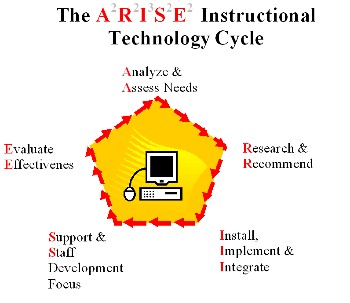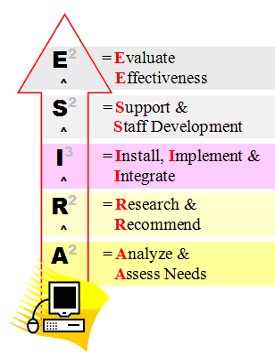ARISE and Manage Your Classroom Technology

By Jennifer J. Farr, Certified New York State Educational Administrator

Now that digital technology is an integral part of many of our classrooms, we have a new challenge: How can we manage this essential technology? How can we maximize the school district’s financial investment? Most importantly, how can we maximize the students’ educational benefit? Unfortunately, in many districts these questions haven’t been asked, much less answered. But it doesn’t have to be that way.
Let’s consider what a good technology management plan would offer:
·It would provide a thoughtful and analytic process for the selection of software programs, online subscriptions, and peripherals.
·It would assure that technologyis assessed for effectiveness on a regular basis.
·It would promote theory-focused professional development rather than software-specific (point and click).
·It would help develop teacher and student skills evenly throughoutthedistrict.
Tools and ideas to transform education. Sign up below.
·It would assure that all curriculum areas can purchase the technology their individual students need to succeed.
·It would help standardize technology purchases in the district .
The A2R2I3S2E2cycle has been designed to address these instructional technology needs.
A2R2I3S2E2 Introduction
The word “Arise” means move upward - effective use of technology moves student achievement and success upward. The Arise Instructional TechnologyCycle allows administrators and educators to integrate technology into the curriculum thoughtfully.The cycle also gives all shareholders in the district the information needed for planning and budgeting purposes.
Underlying Principles of the Plan
·Teachers are the expert professionals responsible for planning and implementing curriculum.
·Technology must be integrated across the curriculum to enhance learning.
·Teachers function as advisers, content experts, and coaches when technology is effectively integrated into all subjects.
·Instructional technology must be evaluated for effectiveness in an well-thought-out manner.
General Overview of the Plan
The following is a proposed timeline for evaluating instructional technology using the A2R2I3S2E2 approach.At the end of a three-year period, the cycle would repeat.The general timeline and process described in this document is a flexible framework; each district can modify the details to suit its specific requirements.
A2R2I3S2E2 Instructional Technology Cycle
Sample Six Year Timeline
Curriculum Strands:
MST = Math, Science, Technology
ELA, SS, LIB & ARTS= English Language Arts, Social Studies, Psychology, Art, Music, and Drama
PE, Health, LOTE, Pupil Services, Career Education, and Business = PE, Athletics, Health, Foreign Language, Speech, Counseling, Family & Consumer Science, Health, Career Education & Business
08/09
09/10
11/12
12/13
13/14
14/15
MST
Strand
A2R2
I3S2
E2
A2R2
I3S2
E2
ELA, SS, LIB
& ARTS Strand
A2R2
I3S2
E2
A2R2
I3S2
PE, Health, LOTE, Pupil Services, Career Education, and Business Strand
A2R2
I3S2
E2
A2R2
Tasks:
A2 =Analyze & Assess Needs
R2= Research & Recommend
I3=Install, Implement & Integrate
S2=Support & Staff Development Focus
E2=Evaluate Effectiveness
Overarching Yearly Goals
YEAR 1
A2 =Analyze & Assess Needs / R2= Research & Recommend
Technology coaches, department chair(s), coordinators, and instructional shareholders work with teachers to analyze the current curriculum in grades K-12. Technology matrices, curriculum maps, standardized scores, and a long-range technology plan are used to assess strengths and weaknesses.
Committee members explore and research potentially useful technologies and review and recommend software, peripherals, and instructional technology strategies that will strengthen the curriculum.Recommendations are presented to district shareholders that could include technology steering committees, administrative council, and BOE members.
YEAR 2
I3=Install, Implement & Integrate / S2=Support & Staff Development Focus
Technology mentors, Computer Teacher Assistants, and/or committee members familiarize themselves with the products and software and develop training programs for the staff.
During this phase there is a strong staff development focus.Instructional leaders and mentors work with principals, staff development coordinators, and technology coordinators to provide training that includes workshops, faculty presentations, and individual instruction.
YEAR 3
E2=Evaluate Effectiveness
Technology coordinators and administrators work withteachers to assess the new technologies using observation, rubrics, student scores, usage reports, workshop evaluations, and questionnaires.Usage reports and findings are used as criteria to begin the cycle again.Data is also shared with other curriculum cycle committee members.

Instructional Technology Plan/Cycle Developed by Instructional Technology Consultant Jen Farr of Farr-Out Links to Learning
Jen Farr is a certified New York State Educational Administrator with 17 years experience working with educators, students and technology. She has published over 150 online educational resources and offers workshops across the country. Jen will also research and develop workshops and training materials that are customized to the needs of your district or corporation. Contact her at Farr-Out Links to Learning
